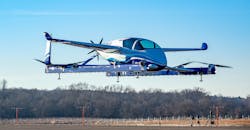First Flight Completed for Boeing’s Autonomous Air Taxi
Boeing NeXt, the aerospace OEM’s development arm urban air-mobility technology, completed the first test flight for its autonomous passenger air vehicle (PAV) prototype. Another Boeing subsidiary Aurora Flight Sciences, designed and developed the electric vertical takeoff and landing (eVTOL) aircraft, and it will continue to test the system to refine the safety and reliability of "on-demand autonomous air transportation."
Efforts like Boeing’s, and others, are seeking to define a market for "urban air mobility", applying autonomous motion, navigation, and unmanned aerial vehicle technology developments to address issues of urban congestion as well as personal transportation, freight and delivery services, and consumer demand.
The PAV prototype completed a controlled takeoff, hover, and landing during the test flight, which tested the PAV’s autonomous functions and ground control systems. "In one year, we have progressed from a conceptual design to a flying prototype," said Boeing chief technology officer Greg Hyslop.
Future flights will test forward, wing-borne flight and the transition from vertical to forward-flight modes.
The PAV system is powered by an electric propulsion system. The prototype airframe integrates the propulsion and wing systems, and the unit measures 30x28 ft (9.14x8.53 meters.) It is designed for fully autonomous flight, takeoff to landing, over a 50-mile range.
"This is what revolution looks like, and it's because of autonomy," stated John Langford, president and CEO of Aurora Flight Sciences, the venture that Boeing acquired last year and maintains now as its in-house source of autonomous flight technologies, for civilian and military applications. "Certifiable autonomy is going to make quiet, clean and safe urban air mobility possible."
The test flight represents the latest milestone for Boeing NeXt. The division works with regulatory agencies and industry partners to lead the responsible introduction of a new mobility ecosystem and ensure a future where autonomous and piloted air vehicles safely coexist. In addition to the PAV, the Boeing NeXt portfolio includes an unmanned fully electric cargo air vehicle (CAV) designed to transport up to 500 pounds (226.80 kilograms) and other urban, regional and global mobility platforms. The CAV completed its first indoor flight last year and will transition to outdoor flight testing in 2019.
"Boeing was there when the aviation industry was born and in our second century, we will unlock the potential of the urban air mobility market," said Steve Nordlund, vice president and general manager of Boeing NeXt. "From building air vehicles to airspace integration, we will usher in a future of safe, low-stress mobility in cities and regions around the world."
